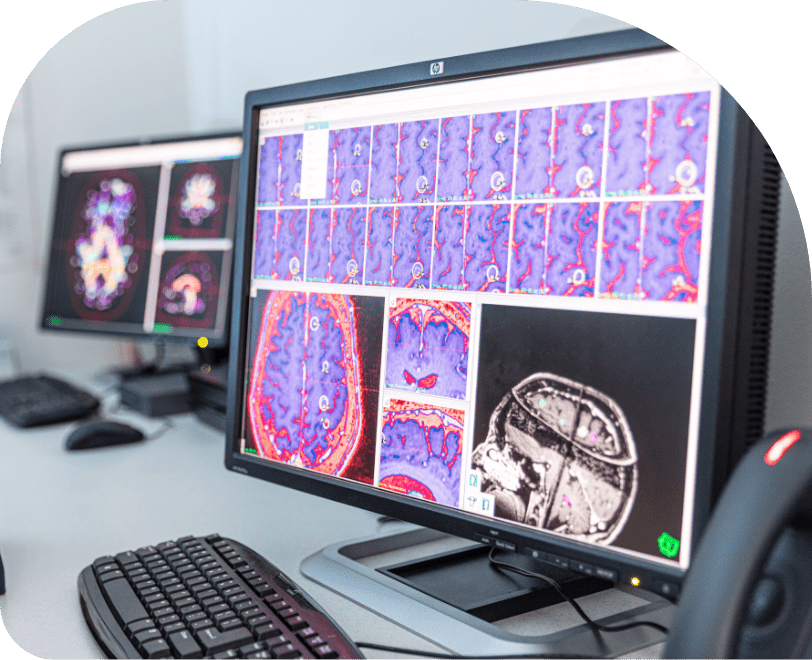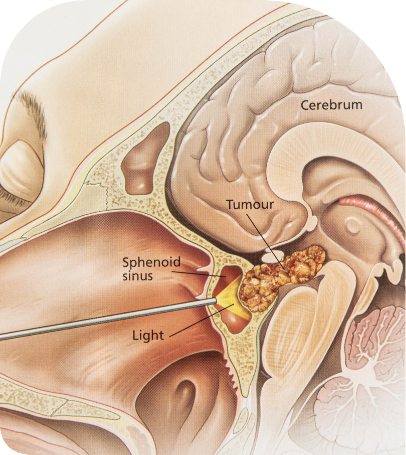Brain Tumours

Neurosurgeons at Macquarie Neurosurgery & Spine are at the forefront of brain tumour surgery in Australia.
Using the latest surgical equipment and techniques, our neurosurgeons form part of a multi-disciplinary team that offers world-class, patient-centred care.
Specialist tumour surgeons at Macquarie Neurosurgery & Spine provide treatment for both benign and malignant tumours, and care for hundreds of patients each year.
Types of brain tumours commonly treated by our specialists

Our specialists manage all types of brain tumours in adults. Tumours commonly seen by our neurosurgeons include:
- Meningioma
Meningiomas arise from the membranes surrounding the brain. Most are not cancerous, but they can cause problems if they put pressure on surrounding brain tissue. - Glioma
This tumour originates from glial cells, which are cells that support and protect nerve cells. Gliomas may be low-grade (slow growing) or high-grade (more aggressive). - Metastasis
A brain metastasis occurs when cancer from elsewhere in the body spreads to the brain. - Pituitary tumours
These are tumours that arise from the pituitary gland in the brain. Most pituitary tumours are not cancerous.
Treatment for brain tumours
The treatment of a brain tumour depends on various factors, including the type of tumour, the nature of the tumour cells (such as low grade vs. high grade), the size and location of the tumour, and the patient’s age, existing medical conditions, and overall health.
Most benign (non-cancerous) tumours typically require surgical removal, though some may be managed with close monitoring, especially if the patient is asymptomatic.
Treatment for malignant (cancerous) brain tumours may involve surgery, radiation therapy, chemotherapy, or a combination of these approaches.

Surgery in and around the skull base | by Prof Di Ieva
Modern brain tumour surgery
At Macquarie Neurosurgery & Spine, our patients receive care from experienced tumour specialists who use the latest technology. Our multidisciplinary team provides compassionate, patient-centred care, ensuring each patient gets the support they need throughout their health journey.
Some of the modern techniques employed by our neurosurgeons are:
Minimally invasive and endoscopic surgery
Minimally invasive (“keyhole”) surgery uses smaller incisions than traditional surgery, and has the advantages of a quicker recovery and a lower likelihood of complications. An endoscope, which is a tiny video camera on the end of a flexible tube, may be used to access the brain during minimally invasive surgery.
Computer-assisted brain surgery
Modern software can be used in conjunction with MRI and CT Imaging, to provide the neurosurgeon with precise information about the region they are operating on, and the location of nerve fibres around the tumour.
Awake brain surgery
Awake brain surgery may be used to ensure that critical parts of the brain are avoided during removal of a brain tumour. During this type of surgery, the patient is awake for part of the procedure. The patient is asked to perform simple tasks, such as talking, while the neurosurgeon uses complex technology to map the functional areas of the brain. These functional areas can then be avoided during removal of the tumour.
Brain Tumour Symptoms
The symptoms of a brain tumour can vary based on its location and size. Sometimes, a brain tumour is discovered incidentally in an individual without symptoms, such as when a CT scan is performed after a head injury.
Symptoms may include:
Headaches
Headaches that are becoming more frequent and severe, or those of recent onset, may require investigation.
Weakness or sensation loss
This may occur on one side of the body, and unlike a stroke, could develop gradually.
Nausea or vomiting
Unexplained nausea or vomiting could be a sign of increased pressure on the brain due to a brain tumour.
Vision problems
These could include blurred or double vision, or loss of the peripheral (outer) visual field.
Seizures
New-onset seizures could be caused by a brain tumour.
Balance problems
Brain tumours situated in the brain’s frontal lobe may lead to balance problems and difficulty walking.
Speech difficulties
In some cases, a brain tumour may contribute to slurred speech or other speech difficulties.
Confusion
Some brain tumours may lead to confusion and forgetfulness.
Frequently asked questions
Brain tumours can be broadly classified into two categories: primary and secondary.
Primary brain tumours originate in the brain or nearby tissue and develop due to changes in the DNA of cells. The exact causes of these DNA changes are currently unknown. There are many types of primary brain tumours, some of which are malignant (cancerous) and others benign (non-cancerous).
Secondary brain tumours originate as cancer in other parts of the body, such as the breast or lungs, and then spread to the brain. Certain cancers have a higher risk of spreading to the brain, though the reasons for this are not yet fully understood.
The onset of symptoms relating to brain tumours can vary, depending on the position, type and growth rate of a tumour. Symptoms may begin suddenly, or they may progress over a longer period of time.
The most commonly reported symptoms of brain tumours are headaches. These are often described as feeling like tension headaches or migraines.
While a family history may increase the risk of brain tumours in certain cases, it is rare for brain tumours to have a genetic cause.
Data suggests that approximately 1900 malignant brain tumours are diagnosed in Australia each year. While benign tumours are believed to be more common than malignant tumours, widespread data is not currently available.
Disclaimer
All information is general and is not intended to be a substitute for professional medical advice.
References
- Cancer Council, Understanding Brain Tumours, https://www.cancer.org.au/assets/pdf/understanding-brain-tumour-booklet, [accessed 25 July 2024]
- Mayo Clinic, Brain Tumor – Symptoms and Causes, https://www.mayoclinic.org/diseases-conditions/brain-tumor/symptoms-causes/syc-20350084, [accessed 25 July 2024]
- Vecht CJ, Kerkhof M, Duran-Pena A. Seizure prognosis in brain tumors: new insights and evidence-based management. Oncologist. 2014 Jul;19(7):751-9. doi: 10.1634/theoncologist.2014-0060. Epub 2014 Jun 4. PMID: 24899645; PMCID: PMC4077452.
